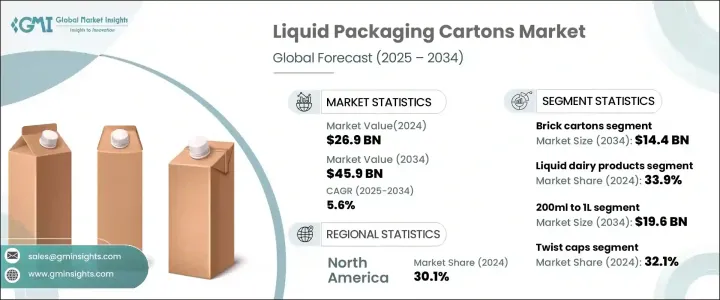
세계의 액체 포장용 카톤 시장은 2024년에 269억 달러로 평가되었으며, 2025-2034년 CAGR 5.6%를 나타낼 것으로 예측됩니다.
패키지 음료 수요 증가와 전자상거래의 활황이 시장 확대에 박차를 가하고 있습니다. 소비자들이 액체용의 편리하고 오래가는 안전한 포장 솔루션을 찾는 가운데 시장은 안정적인 속도로 성장을 거듭하고 있습니다. 지속 가능한 패키징에 대한 인식의 고조도 시장의 밝은 전망에 기여하고 있으며, 각 브랜드는 플라스틱 폐기물을 줄이기 위해 친환경 대체품에 투자하고 있습니다.

무균 포장은 이 성장을 가속하는 중요한 요소이며 액체 제품의 품질 및 안전성을 유지하면서 유통 기한을 연장할 수 있습니다. 유제품, 주스, 식물성 음료, 액체 식품에 대한 기호는 액체 포장용 카톤의 채택을 계속 가속화하고 있습니다. 게다가 외출처에서 소비 동향의 고조가, 음료 메이커에 컴팩트하고 사용하기 쉬운 카톤 솔루션의 채용을 재촉하고 있습니다. 택배 식품의 확대 및 영양 강화 음료, 오가닉 음료에 대한 기호의 고조도, 시장의 기세를 한층 더 가속시키고 있습니다. 규제 기관이 플라스틱 포장 규제를 강화하는 가운데 제조사들은 재활용 가능하고 생분해 가능한 카톤 솔루션을 제공하고 환경 기준 적합성을 확보하기 위해 빠르게 기술 혁신을 진행하고 있습니다. 이러한 동향이 견인차가 되어, 액체 포장용 카톤 시장은 향후도 지속적인 성장이 전망됩니다.
| 시장 범위 | |
|---|---|
| 시작 연도 | 2024년 |
| 예측 연도 | 2025-2034년 |
| 시작 금액 | 269억 달러 |
| 예측 금액 | 459억 달러 |
| CAGR | 5.6% |
시장은 유형별로 구분되며, 브릭 카톤, 게이블 탑 카톤, 변형 카톤 및 기타가 업계를 선도하고 있습니다. 브릭 카톤은 내구성, 효율적인 공간 이용, 긴 유통 기한에서 우위를 점하고 있습니다. 이 카톤들은 유제품이나 주스 포장에 널리 사용되고 있으며, 제품의 무균성과 안전성을 확보하는 무균 보호를 제공하고 있습니다. 냉장하지 않고 유통기한을 늘릴 수 있기 때문에 세계 시장에 대응하는 브랜드에 있어서 좋은 선택지가 되고 있습니다. 건강 지향의 소비자가 방부제 무첨가의 선택사항을 요구하는 가운데, 무균 브릭 카톤은 업계 표준이 되고 있어 제품의 완전성을 유지하면서 보다 긴 신선도를 확보하고 있습니다.
시장은 용도별로 분류되며, 주요 부문은 액체 식품, 액체 유제품, 비탄산 청량 음료, 알코올 음료 등입니다. 2024년에는 세계 유제품 소비 증가에 견인되어 액체 유제품 부문이 큰 시장 점유율을 차지했습니다. 특히, 강화 유제품이나 플레이버 유제품이 선진 패키징 솔루션의 수요를 촉진하고 있습니다. 하이 배리어 코팅을 특징으로 하는 아셉틱 카톤은 유제품 부문에서 지지를 모으고 있으며 냉장이 필요 없이 품질을 유지하고 유통기한을 연장하고 있습니다.
미국의 액체 포장용 카톤 시장은 크게 성장해 2034년에는 143억 달러에 이를 것으로 예상됩니다. 건강 의식의 고조 및 아몬드 밀크나 오토 밀크 등의 식물성 음료의 인기의 고조가 주요한 성장 촉진 요인입니다. 제조사들은 보존성을 향상시키고 제품의 신선도를 유지하기 위해 무균 포장 솔루션을 급속히 채택하고 있습니다. 보다 오래 지속 가능한 패키징 솔루션으로의 이행은 미국 내외의 액체 포장용 카톤 시장의 성장을 촉진할 것으로 예상됩니다.
The Global Liquid Packaging Cartons Market was valued at USD 26.9 billion in 2024 and is projected to grow at a CAGR of 5.6% between 2025 and 2034. The rising demand for packaged beverages and the booming e-commerce sector are fueling market expansion. As consumers seek convenient, long-lasting, and safe packaging solutions for liquids, the market continues to grow at a steady pace. Increasing awareness of sustainable packaging is also contributing to the market's positive outlook, with brands investing in eco-friendly alternatives to reduce plastic waste.

Aseptic packaging is a key factor driving this growth, allowing liquid products to retain their quality and safety while extending shelf life. The preference for dairy, juices, plant-based beverages, and liquid foods continues to accelerate the adoption of liquid packaging cartons. In addition, the rise of on-the-go consumption trends is pushing beverage manufacturers to adopt compact, easy-to-use carton solutions. The expansion of food delivery services and the increasing preference for fortified and organic beverages further contribute to market momentum. With regulatory bodies tightening restrictions on plastic packaging, manufacturers are rapidly innovating to provide recyclable and biodegradable carton solutions, ensuring compliance with environmental standards. As these trends gain traction, the liquid packaging cartons market is positioned for sustained growth in the years ahead.
| Market Scope | |
|---|---|
| Start Year | 2024 |
| Forecast Year | 2025-2034 |
| Start Value | $26.9 Billion |
| Forecast Value | $45.9 Billion |
| CAGR | 5.6% |
The market is segmented by type, with brick cartons, gable top cartons, shaped cartons, and others leading the industry. Brick cartons dominate due to their durability, efficient space utilization, and long shelf life. These cartons are widely used in dairy and juice packaging, offering aseptic protection that ensures product sterility and safety. Their ability to extend shelf life without refrigeration makes them a preferred choice for brands catering to global markets. As health-conscious consumers demand preservative-free options, aseptic brick cartons are becoming an industry standard, ensuring longer freshness while maintaining product integrity.
The market is also categorized by application, with key segments including liquid foods, liquid dairy products, non-carbonated soft drinks, and alcoholic beverages. In 2024, the liquid dairy products segment held a significant market share, driven by increasing global dairy consumption. Fortified and flavored dairy products are particularly fueling demand for advanced packaging solutions. Aseptic cartons, which feature high-barrier coatings, are gaining traction in the dairy sector, preserving quality and extending shelf life without the need for refrigeration.
The U.S. liquid packaging cartons market is set to grow significantly, reaching USD 14.3 billion by 2034. Rising health awareness and the growing popularity of plant-based beverages, such as almond and oat milk, are key growth drivers. Manufacturers are rapidly adopting aseptic packaging solutions to improve shelf life and maintain product freshness. This transition toward longer-lasting and sustainable packaging solutions is expected to propel the growth of the liquid packaging cartons market across the U.S. and beyond.